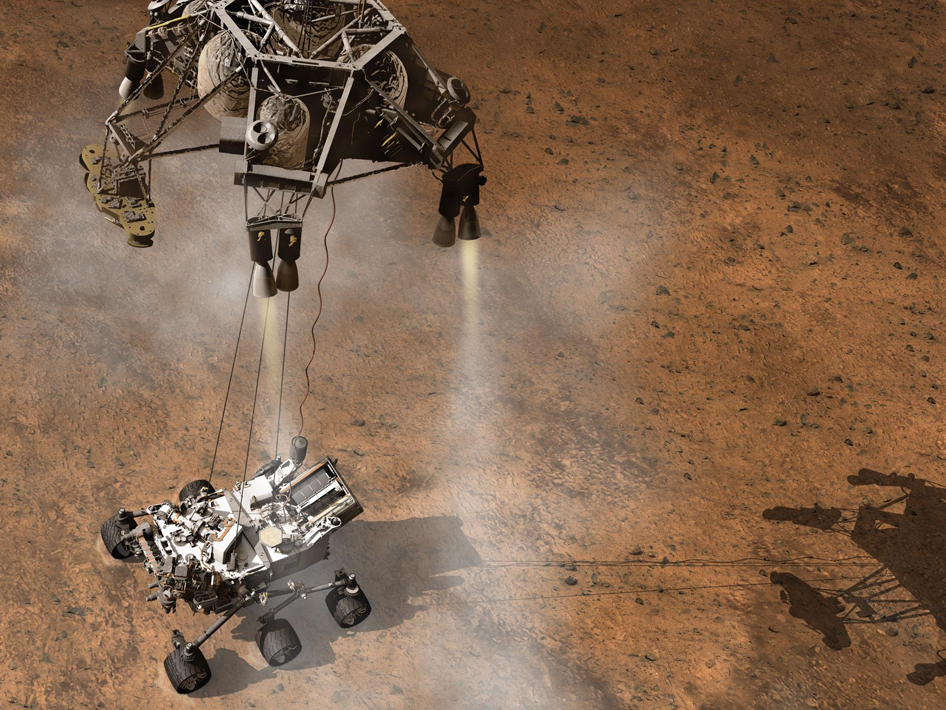
Time flies, on Mars as well as Earth.
It's been seven years since NASA's Curiosity rover aced its Red Planet touchdown, a harrowing and seemingly improbable maneuver that had people around the world glued to their phones and laptop screens.
On the night of Aug. 5, 2012, a rocket-powered sky crane lowered the car-size Curiosity rover onto the floor of Gale Crater on cables, then detached and flew off to crash-land intentionally a safe distance away. When the success of this unprecedented move became apparent, mission control at NASA's Jet Propulsion Laboratory in Pasadena, California, erupted in raucous cheers, which in some cases transitioned to tears of joy and relief.
Related: Amazing Mars Photos by NASA's Curiosity Rover (Latest Images)
And Curiosity has been going strong, and making exciting discoveries, ever since. For example, the rover quickly determined that the 96-mile-wide (154 kilometers) crater had hosted a lake-and-stream system in the ancient past. And further observations suggested that this environment was habitable for long stretches, perhaps hundreds of millions of years at a time.
Curiosity has also detected several surges of methane in Gale Crater's air. These spikes intrigue astrobiologists, because the vast majority of Earth's atmospheric methane was produced by microbes and other organisms. The Mars methane is not a definitive sign of life, however, because the gas can be produced abiotically as well. This can happen via reactions between hot water and certain types of rock, for example.
In September 2014, Curiosity made it to the base of Mount Sharp, the mysterious mountain that rises 3.4 miles (5.5 km) into the sky from Gale's center. The six-wheeled robot began working its way up through Mount Sharp's foothills, seeking more clues about Mars' wetter, warmer past and its shift to the cold and dry planet we know today.
Get the Space.com Newsletter
Breaking space news, the latest updates on rocket launches, skywatching events and more!
The rover continues such work today, long after its warranty expired: Curiosity's prime mission ran for one Mars year, or about 687 Earth days.
Curiosity has had some memory problems and issues with its rock-boring drill over the years, but the rover remains in good health overall, mission team members have said. And Curiosity could keep going for a while longer yet. The rover's multimission radioisotope thermoelectric generator (MMRTG), which converts the heat of radioactive decay to electricity, has an operational lifetime of 14 years.
This nuclear power source, by the way, means that Curiosity is better equipped to handle monster Mars dust storms, such as the one that killed NASA's solar-powered Opportunity rover last year. (Dust coated Oppy's solar panels, depriving the rover of power.)
So, Curiosity may well live to welcome two more rovers to the Red Planet: NASA's Mars 2020 rover, whose design is based heavily on that of Curiosity, and the European-Russian ExoMars rover are both scheduled to touch down in February 2021.
Mars 2020 and the ExoMars vehicle, called Rosalind Franklin, represent the next steps in the search for Red Planet life. Curiosity's $2.5 billion mission is focused on assessing Martian habitability, but the two future rovers will both hunt for actual signs of ancient Red Planet organisms.
Other spacecraft have made it to Mars during Curiosity's time there. NASA's MAVEN spacecraft and India's Mars Orbiter Mission both arrived in Mars orbit in September 2014, and the ExoMars Trace Gas Orbiter (TGO) did the same in October 2016. (A landing demonstrator called Schiaparelli that flew with TGO crashed during its touchdown attempt.)
And on Nov. 26, 2018, NASA's InSight lander touched down near the Martian equator to map the planet's interior in unprecedented detail.
- Ancient Mars Lakes & Laser Blasts: Curiosity Rover's 10 Biggest Moments in 1st 5 Years
- Ancient Mars Could Have Supported Life (Photos
- The Search for Life on Mars: A Photo Timeline
Mike Wall's book about the search for alien life, "Out There" (Grand Central Publishing, 2018; illustrated by Karl Tate), is out now. Follow him on Twitter @michaeldwall. Follow us on Twitter @Spacedotcom or Facebook.
Join our Space Forums to keep talking space on the latest missions, night sky and more! And if you have a news tip, correction or comment, let us know at: community@space.com.

Michael Wall is a Senior Space Writer with Space.com and joined the team in 2010. He primarily covers exoplanets, spaceflight and military space, but has been known to dabble in the space art beat. His book about the search for alien life, "Out There," was published on Nov. 13, 2018. Before becoming a science writer, Michael worked as a herpetologist and wildlife biologist. He has a Ph.D. in evolutionary biology from the University of Sydney, Australia, a bachelor's degree from the University of Arizona, and a graduate certificate in science writing from the University of California, Santa Cruz. To find out what his latest project is, you can follow Michael on Twitter.









